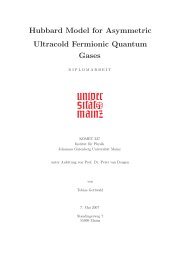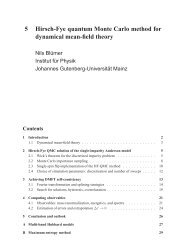Ewald Sum - komet 337
Ewald Sum - komet 337
Ewald Sum - komet 337
You also want an ePaper? Increase the reach of your titles
YUMPU automatically turns print PDFs into web optimized ePapers that Google loves.
<strong>Ewald</strong> <strong>Sum</strong>mation<br />
for<br />
longrange potential<br />
Seminar talk for „Computer simulations in statistical physics“<br />
08.02.2007<br />
Alexander Baade
● Motivation<br />
Content<br />
● Derivation of the <strong>Ewald</strong> <strong>Sum</strong><br />
● Implementations<br />
PaulPeter<strong>Ewald</strong><br />
(18881985)<br />
from[4]<br />
1
Motivation<br />
Consider a box of N charged particles with periodic boundary<br />
conditions and volume L³:<br />
Try to calculate the overall potential<br />
2
qi<br />
Motivation<br />
) Minimum Image (spherical truncation)<br />
r c<br />
q i<br />
Truncate potential at distance r c<br />
One can show: The contribution of the ignored tail of the potential U(r) can<br />
be estimated to be<br />
U tail =<br />
N �<br />
2 ∫ ∞<br />
r c<br />
dr U �r�4�r 2<br />
Tail correction diverges, unless U(r) decays faster than r 3<br />
Not suitable for e.g. Coulomb potential (r 1 )<br />
3
a) Truncate anyway!<br />
Motivation<br />
Solutions<br />
advantage: no costly calculation of longrangeinteraction<br />
downside: serious inaccuracies<br />
b) Compute long range interactions<br />
Several methods:<br />
i) <strong>Ewald</strong> sum<br />
ii) Fast Multipole method<br />
iii) Particlemeshbased techniques<br />
Of these methods, <strong>Ewald</strong> <strong>Sum</strong>mation is still the most widely used<br />
one<br />
4
Return to our box:<br />
<strong>Ewald</strong> <strong>Sum</strong><br />
Assume: System as a whole is electrically neutral<br />
Now compute the contribution to the potential<br />
energy of this Nparticle system:<br />
where<br />
is the electrostatic potential.<br />
U Coul = 1<br />
2 ∑ N<br />
i=1<br />
��r i �=∑ j , �n<br />
'<br />
q i ��r i �<br />
q i<br />
∣�r ij�nL∣ �<br />
�n denotes the summation over all periodic images, the prime indicates<br />
that the selfpotential for i=j is omitted.<br />
,<br />
5
<strong>Ewald</strong> <strong>Sum</strong><br />
Problem:<br />
U Coul = 1<br />
2 ∑ N<br />
i=1<br />
q i ��r i �<br />
is only slowly (in fact conditionally) convergent.<br />
Idea: Consider that every particle q i is surrounded by a diffuse charge<br />
distribution of opposite sign but same magnitude,such that it cancels q i .<br />
6
<strong>Ewald</strong> <strong>Sum</strong><br />
Now the interaction becomes shortranged, as the diffuse distribution<br />
screens some part of the charge.<br />
Of course we have to correct for the fact, that we added a potential by<br />
adding another potential with the same sign as the original potential:<br />
+ =<br />
7
<strong>Ewald</strong> <strong>Sum</strong><br />
The compensating charge density varies smoothly in space and is<br />
periodic, hence can be represented by a (rapidly converging Fourier<br />
series).<br />
General idea of <strong>Ewald</strong> <strong>Sum</strong>mation:<br />
i) <strong>Sum</strong> screened particle interactions in real space<br />
ii)Subtract compensating potential in Fourier space.<br />
put differently:<br />
1<br />
r<br />
= f �r�<br />
r<br />
�1− f �r �<br />
r<br />
8
U Coul = 1<br />
2V ∑ �k≠�0<br />
−� �<br />
� �<br />
1<br />
<strong>Ewald</strong> <strong>Sum</strong><br />
4 �<br />
k 2∣���k�∣² exp� −k²<br />
4� �<br />
N<br />
2 ∑i=1<br />
2<br />
qi � 1<br />
2 ∑ N<br />
qi q j erfc���r ij� i≠ j rij N<br />
2�<br />
�<br />
�2 �'�1�V ∣∑<br />
i=1<br />
�r i q i∣ ²<br />
Fourier contribution<br />
Selfpotential correction<br />
Realspace contribution<br />
Boundary effects<br />
9
Basics for implementation<br />
Standard <strong>Ewald</strong> implementation scales like N 2<br />
Most costly part: Fourier transformation<br />
Process can be speeded up by a method called<br />
„Fast Fourier Transformation“ (FFT)<br />
3 popular algorithms, that implement FFT:<br />
1) Particleparticleparticle mesh (P 3 M)<br />
2) Particle mesh <strong>Ewald</strong> (PME)<br />
3) Smooth particle mesh <strong>Ewald</strong> (SPME)<br />
10
Basics for implementation<br />
Implementation steps<br />
All 3 algorithms implement 4 steps:<br />
1) Charge assignment<br />
2) Solving Poisson's Equation<br />
3) Differentiation<br />
4) BackInterpolation<br />
11
Basics for implementation<br />
Charge Assignment<br />
FFT is a finite and discrete Fourier transformation, thus point charges with<br />
continuous coordiates have to be replaced by a grid based charge<br />
density.<br />
Define an even function W( �x ) such that the fraction of charge at<br />
position is given by W( �x �x ), where is a mesh point.<br />
�x p �x p<br />
12
Basics for implementation<br />
Charge Assignment<br />
Properties of a suitable charge assignment function W:<br />
charge conservation<br />
finite and possibly small support<br />
localisation of discretisation error<br />
smooth<br />
minimisation of aliasing errors<br />
easy and transparent implementation<br />
Not all properties can be achieved at the same time<br />
13
Basics for implementation<br />
by no means trivial<br />
Solving Poisson's Equation<br />
−����r �=4 � ���r �<br />
different realisations in the three algorithms<br />
14
Basics for implementation<br />
Differentiation<br />
To obtain the Forces exerted on the particles are obtained by<br />
differentating the potential. For the Fourier space part there exist several<br />
possibilities:<br />
1) Differentation in Fourier space<br />
(relatively easy, computationally demanding)<br />
2) Analytic differentiation of the assignment function in real space<br />
(very fast, does not conserve momentum)<br />
3) Discrete differentiation on the mesh in real space<br />
(fourier part fast, nonlocal)<br />
15
Basics for implementation<br />
Backinterpolation<br />
At one point one has to interpolate the mesh based results back to the<br />
actual particles.<br />
This is done similarly to the charge distribution via some assignment<br />
function W.<br />
It is convenient to use the same assignment function onto and from the<br />
mesh.<br />
16
Basics for implementation<br />
Comparison of the algorithms and the significance of �<br />
∆F<br />
from [3]<br />
�<br />
PME<br />
SPME<br />
P 3 M<br />
17
Time to say...<br />
Thank you!
References<br />
[1] D. Frenkel/ B.Smit „Understanding Molecular Simulations“ , Academic<br />
Press, San Diego, 2002<br />
[2] Allen / Tildsley : „Computer Simulation of Liquids“<br />
[3] M. Deserno / C. Holm „How to mesh up <strong>Ewald</strong> sums (I)“ , J. Chem.<br />
Phys. 109, 7678(1998)<br />
[4] http://www.xray.cz/













